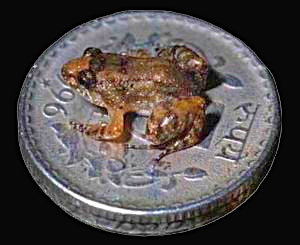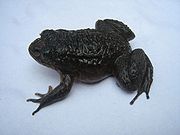New Wrinkled Frog Discovered
Posted by: Loren Coleman on November 6th, 2008
Nyctibatrachus dattatreyaensis (above), a new species of frog that is very wrinkled, has been discovered in India.
This is species has been described from the montane Shola forests of Dattatreya Peeta, Bhadra Wildlife sanctuary, Karnataka, southwestern India. This new frog is active during the night (like others in its genus).
Nyctibatrachus dattatreyaensis is a 40-mm-sized frog which differs from the other closely-related species in having a high degree of small corrugations on the body with prominent discontinuous lateral folds.
The new-found species have golden yellow eyes with black rhomboidal pupil and the upper surface of its body is reddish black to stone black with two yellow lateral bands.
“The dorsal color of the species camouflages with the ferruginous substratum of its habitat which is essential for its survival from predators,” the discoverers (Dinesh, KP, Radhakrishnan C. & Gopalakrishna Bhatta) note.
The finding has been published in the October 2008 edition of Zootaxa, the important zoology journal of New Zealand.
The discovery assumes significance as it has come in the “Year of the Frog” as declared by the Amphibian Ark – a joint effort of the World Association of Zoos and Aquariums (WAZA).
As per the current studies, the species is limited to the hilly ranges surrounding the Bhadra Wildlife Sanctuary in India and is not found anywhere else in the world.

The tiny night frog, Nyctibatrachus minimus (above), discovered in 2007, is related to the new 2008 discovery.
The genus Nyctibatrachus is endemic to Western Ghats and the species, named after Lord Dattatreya worshipped in Chikmagalur, is one among the 16 nominal species known in the world.
The new 2008 species’ characteristics, in summary, are the head wider than long; skin on the dorsum highly wrinkled with transverse corrugated folds; three discontinuous longitudinal folds, one dorsolaterally and two laterally; webbing on toes medium (3/4th); two yellowish bands on the dorsolateral area, prominent from sub-adult to adult stage; and femoral glands present.
Reference: Dinesh, KP, Radhakrishnan C & Gopalakrishna Bhatta (2008) A new species of Nyctibatrachus Boulenger (Amphibia: Anura: Nyctibatrachidae) from the surroundings of Bhadra Wildlife Sanctuary, Western Ghats, India, Zootaxa 1914: 45–56.
About Loren Coleman
Loren Coleman is one of the world’s leading cryptozoologists, some say “the” leading living cryptozoologist. Certainly, he is acknowledged as the current living American researcher and writer who has most popularized cryptozoology in the late 20th and early 21st centuries.
Starting his fieldwork and investigations in 1960, after traveling and trekking extensively in pursuit of cryptozoological mysteries, Coleman began writing to share his experiences in 1969. An honorary member of Ivan T. Sanderson’s Society for the Investigation of the Unexplained in the 1970s, Coleman has been bestowed with similar honorary memberships of the North Idaho College Cryptozoology Club in 1983, and in subsequent years, that of the British Columbia Scientific Cryptozoology Club, CryptoSafari International, and other international organizations. He was also a Life Member and Benefactor of the International Society of Cryptozoology (now-defunct).
Loren Coleman’s daily blog, as a member of the Cryptomundo Team, served as an ongoing avenue of communication for the ever-growing body of cryptozoo news from 2005 through 2013. He returned as an infrequent contributor beginning Halloween week of 2015.
Coleman is the founder in 2003, and current director of the International Cryptozoology Museum in Portland, Maine.











Great discovery. Interesting little feller.
I wondered how they determined that he was a frog, and not a toad, so I Googled it:
1 – “The skin of a frog is smooth, and a toad is more rough, or ‘warty’.”
Well, he sure looks more ‘toady’ than ‘froggy’ in that picture.
2 – “A frog feels moist to the touch, but a toad feels dry.”
Hard to tell. He looks sort of dry in the illustration. (Tip: A good lotion does wonders for dry skin – and it could help with those wrinkles as well.)
3 – “A frogs back is raised with two ridges down each side. Toads have a more flattened appearance.”
In the photo, he looks sort of flat to me. But he could just be tired, and lying down to rest.(?)
4 – “Frogs move around by hopping on their strong back legs. Toads walk.”
This one surprised me. The little Spade Foots in my backyard must not know this. Either that, or they’re just an unusually hyperactive bunch. I’d better stop dumping those coffee grounds around the shrubbery.
5 – “When in doubt, it comes down to who their closest relative is genetically, bufo or rana.”
There you go folks, it always seems to come down to whom you’re related to. 😉
The wrinkles and folds that distinguish this one from other closely related species are an interesting feature to me. I find myself wondering precisely why this species has evolved this adaptation as well as what sort of survival advantage the folds and corrugations incur in this case. I’m fascinated by the factors that cause animals to develop different features from other related species (like these folds) in response to their particular niche and habitat.
All toads are frogs but not all frogs are toads. If that makes any sense.